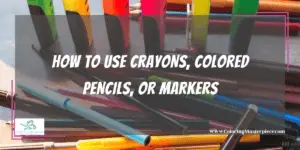Crayons, colored pencils, and markers can all be used for coloring in coloring books, on paper, or even on walls (although this is usually not an approved medium). All produce colorful results that can be enjoyed by the colorist and by viewers. They are, however, somewhat different from each other, both in their construction and in the ways they can be used.
Crayons, colored pencils, and markers are each valid coloring medium. Crayons are excellent at broad coloring expenses and will resist additional applications of any water-based medium – including markers. Colored pencils are your best choice if you need to do something fine and delicate and if you might need to mix or blend colors. Markers provide bright colors and may or may not be waterproof, depending upon the type selected. They can have fine points or broad points, depending upon the marker selected.
For double-sided coloring pages, it is best to use crayons or colored pencils. However, for single-sided work, markers provide bold colors that will remain bright.
How to Use Crayons, Colored Pencils, or Markers

As mentioned above, crayons, colored pencils, or markers are frequently used to create art. They can be employed to color in coloring books, create colored sketches, or even produce finished artwork. The only limits on their ability to make something beautiful are in the skill and imagination of the artist. With that said, they each have different properties and will, therefore, produce different results when applied to a surface.
Crayons
They are made from wax. Therefore they are a water-resistant medium. They can be layered, allowing for an interesting technique called “scratch-art,” but do not blend well unless they are the alternative “crayon” commonly known as oil pastels – which will blend but is incredibly messy to work with. Oil pastels are not a good medium for young artists since they have properties similar to oil paints. Crayons, on the other hand, are relatively non-toxic and are low-mess when used appropriately. This makes them a good medium for the youngest artists. But do not sell them short! In the hand of a master artist, a crayon can as easily produce a masterpiece as oil on canvas.
Colored Pencils
They are similar to crayons in that the color core is usually either a wax or oil base with a dye that can be transferred to paper. With that said, there are differences in the composition of the core from that of crayons. These differences make colored pencils easier to blend.
In addition, colored pencils can be sharpened to a fine point, making them more precise in their application, as compared to crayons. Although crayons can be sharpened, they quickly lose their fine point, although they are excellent for covering wide expanses of the blank medium.
Markers or Marking Pens
They more nearly resemble pen and ink than crayons or colored pencils. Markers frequently have a felt center that is encased in a tube that is tipped with an applicator. The applicator might be a hardened felt, or it could have a ballpoint. The ink can be water-soluble or indelible (not possible to dilute or dissolve). Markers made for classroom use are usually water-soluble and non-toxic, making clean-up easier. This is especially important if young artists decide that classmates are a better art surface than their paper! But it is also useful for older artists who become engrossed in their work and forget to pay attention to how a hand or sleeve might drag across work or how a pen thrust into hair or over the ear might make a mark on the face.
Markers tend to be brighter than either crayons or colored pencils. They hold their color longer, and it is not subject to wax bloom since no wax is involved. With that said, markers have a bleed-through effect thanks to their resemblance to ink. Therefore, it is not possible to color on both sides of a page when using markers.
Some coloring books are designed to accommodate this property and are only printed on one side of the page. Other books, however, are not, so it is a good idea to check the back of your page before applying markers to a picture. You would not want to lose one picture while developing another!
Check out our coloring tips HERE.
Specialized, Unique Applications

Each of these three coloring methods has special applications that are not duplicated by the other two. Here are a few of them.
- Crayons resist water. Therefore, they can be used to make “crayon resists,” that is, pictures that are drawn or picked out using crayons but are completed by adding a watercolor wash. This property also allows them to be used in the creation of batik fabric printing or pysanky eggs. Both batik and pysanky can be created with plain wax, but the colored crayons can help track your design as you create it.
- Colored Pencils are excellent for sketching, hatching, crosshatching, and creating color drafts for more permanent mediums. They are also perfect for paper dolls, fashion designs, and similar applications that require fine, delicate drawings.
- Markers or Marking Pens can be substituted for uses that once required specialized steel nibs for ink stick pens. They are perfect for quick applications such as making advertising posters for school events. With that said, if you are coloring a mandala to use in meditation, markers are less likely to run and are far less messy in application than inks. The only disadvantage is that the marker inks cannot be mixed to produce other colors. However, this can be overcome by using hatching, crosshatching, or pointillism (dots) to engage the eye in visual mixing.
Conclusion
For differences between crayons, colored pencils, and markers, it is easiest first to say how they are alike: all can be used to color pictures or to create artwork. Crayons are usually wax or oil-based cylinders that can deliver color to a page. They are frequently covered by a paper tube to help protect the user’s fingers from stains. Colored pencils are similar to crayons in that their central core is wax or oil mixed with dye. However, instead of being surrounded by paper, the slender color core is encased in wood. Unlike the first two, markers are more like an ink pen. They are usually made by encasing a felt base that has been soaked in color or a tube that simply contains colored ink inside a protective tube. The ends of the markers can be either a shaped hard felt, or they can even be a ballpoint that dispenses ink. In a few cases, the ends are tipped with a delivery method that is nearly like a paintbrush.
Frequently Asked Questions
My geography assignment is to draw and color a map of the Thirteen American Colonies as they appeared in 1776. Which medium should I use?
You could use any of the three mediums mentioned, but colored pencils will give you the greatest control over the placement of your colors. You can add texture via hatching or pointillism. If you are creating a contour map, you could use watercolor pencils and lightly brush parts of your map with water.
I want to create complicated designs on my Easter eggs, but I do not want to make pysanky eggs. The designs will be for a coloring contest.
Wax crayons will be your best choice. You could use some pysanky tools if you wish to make the designs more delicate. The technique would be as follows:
-
- First, hard boil your eggs a little longer than you would for eating.
- Second, begin applying the first color design while the egg is still warm – it will help the crayon’s wax stick to the egg.
- Third, dip all or part of the egg in pre-mixed easter egg dye.
- Fourth, apply more crayons to the egg’s surface to enhance your original design, then dip the egg again – either in the same color or in a different one.
My 4-H Club needs a big sign to advertise a bake and craft sale. It is important to make as many signs as we can because this is an important fundraiser for us. But I do not want to spend all day coloring with little, tiny markers.
Your best medium is going to be large lettering markers. Your color palette is going to be limited, but the tips for these markers are extra wide and will allow you to create large letters without “coloring.” Instead, you can practice your lettering techniques.
I have just purchased my first house. I have these lovely, white walls, and I am itching to draw on them. However, if I do not like my artwork, I will want to paint it. What is my best medium?
To paint over your work and create a new blank space, you will want a water-based medium, such as watercolor pencils or water-soluble markers. Avoid crayons, permanent markers, or wax or oil-based pencils as these will act as a resist, and you will have your design permanently on the wall.
Maximize the benefits of coloring with my free adult coloring eBook and by signing up for my email newsletter HERE!
Disclaimer: The information provided by ColoringMasterpiece.com (“The Site”) is for general informational purposes only. All information on the Site is provided in good faith, however, we make no representation or warranty of any kind, express or implied, regarding the accuracy, adequacy, validity, reliability, availability, or completeness of any information on the Site. Under no circumstance shall we have any liability to you for any loss or damage of any kind incurred as a result of the use of the Site or Reliance on any information provided on the Site. Your use of the Site and your reliance on any information on the Site is solely at your own risk. This blog post is for educational purposes only and does not constitute legal advice. Please consult a legal expert to address your specific needs.
Terms and Conditions: https://coloringmasterpiece.com/terms-and-conditions/

